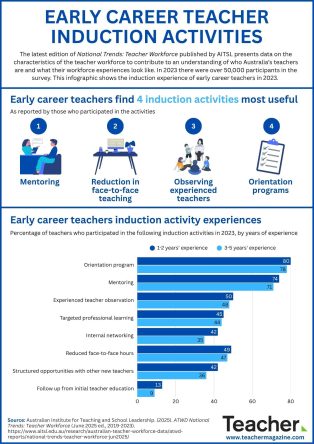Sharing national workforce data allows teachers to see how their experiences compare to others, how the broader profession is structured and how teachers’ insights relating to the challenges they face can lead to change. Each year, the Australian Institute for Teaching and School Leadership’s (AITSL) Australian Teacher Workforce Data (ATWD) initiative collects data from higher education providers, teacher regulatory authorities and teachers themselves on topics important to the national teacher workforce.
The data released in the ATWD’s report – National Trends: Teacher Workforce – and Data Portal, largely come from the annual Australian Teacher Workforce Survey. This survey is open to all registered teachers across Australia – whether they’re working as teachers, middle leaders (heads of departments or subject areas) or senior leaders (principals) in schools or early childhood settings, taking a break, or if they’ve left teaching but are maintaining their registration. In today’s article, Dr Gillian Clark, Alex Allan and Dr Susan-Marie Harding from AITSL provide a snapshot of the findings. They also share data on teachers’ career progression, how they work and what they spend their valuable time on.
The Australian Teacher Workforce Data (ATWD) Initiative offers key insights, directly from teachers and leaders, that can help employers understand both the pressures and opportunities teachers are facing, and the trends that sit beneath the headlines. The Australian Teacher Workforce Survey is conducted in every state and territory across Australia and captures the experiences of around 50,000 registered teachers each year. It is the only yearly survey that the entire teaching profession is invited to participate in. The results presented come from the 2023 survey, which ran from August to November 2023.
Teacher experience and leadership roles
When it comes to the experience levels of teachers, the latest data show the teaching profession is highly experienced with many teachers (38%) having more than 20 years in the profession. There is a mix of teachers across the career stages with 42% at 6-19 years’ experience, a key period for taking on leadership responsibilities. With new teachers entering the profession every year, the pool of early career teachers (20% of the workforce) is strong, bringing new talent into our classrooms.
While many leaders, particularly senior leaders, have spent numerous years in teaching, this is not always the case. Of teachers who have been in the profession for 6-9 years, almost one-third (29%) are leaders, and 9% of teachers in their early career (1-5 years in the profession) are in leadership roles. Indeed, half (49%) of those who are head of a department and 16% of principals had been in the teacher workforce for 10 years or less when they first stepped into those roles. This shows there are opportunities for talented teachers to take on leadership roles relatively early in their careers.
Most (69%) of the teacher workforce are employed on permanent/ongoing contracts, and this has slowly but steadily increased over time. Some (15%) are on fixed-term contracts, with 16% in casual/relief positions. The proportion on casual contracts has remained quite stable over time, though the main reason teachers report for taking up casual employment has shown some change. The proportion taking on casual roles because they can’t find a permanent or fixed-term position has decreased from 24% in 2019 to 11% in 2023. This indicates that, over time, more teachers have been able to find employment that suits their needs.
Contract types vary by experience level and position. For instance, almost all middle (92%) and senior (86%) leaders are employed on ongoing contracts. A lower proportion (48%) of early career teachers are employed on an ongoing basis, with one-quarter (24%) employed on short-term contracts, and 19% employed on casual/relief contracts. This may indicate that new graduate teachers take up short-term positions as a way into the workforce, allowing them to build experience before gaining permanent positions.
Around one-third (30%) of the teacher workforce are contracted for part-time hours. Part-time work is quite common for those deployed in early childhood settings (39% part-time), and classroom teachers in primary schools (30% part-time). Leadership positions are also able to be part-time roles in some circumstances. While most middle leaders are contracted to work full-time hours, 8% of middle leaders are contracted to work around 4 days per week, and another 8% for less than 4 days. There is also a small proportion of senior leaders working part-time (4% contracted for 4 days per week, and another 4% for less than 4 days).
These data can help teachers situate their own employment experience within the broader national context, offering a clearer view of how common different arrangements are across the profession. The information also supports national conversations about job security, flexibility and staffing – issues that shape teaching conditions and important considerations in policy and workforce planning.
Teacher and leader workload and duties
A key improvement required for teachers is a reduction in workload. While median weekly working hours reduced from 2019 to 2023 by around 5 hours, full-time teachers and leaders reported working a median of 50-55 hours per week during school terms in 2023.
A teacher’s time is split between face-to-face teaching – which takes a median of 21-25 hours per week – and a variety of other duties such as preparing lessons, communicating with parents, counselling students, and administrative tasks. Examining the time spent on various duties helps to show governments and systems where to target supports to make the biggest difference to teachers’ workloads. These data also offer school leaders insight into how staff typically spend their time and where pressure points might be, which can prompt conversations around areas for additional support, professional development, or changes to responsibilities.
Full-time classroom teachers reported spending over 9 hours per week on lesson-planning, with over 5 hours per week spent on each of the following tasks: marking/assessment, administration, and teamwork with colleagues. When compared to survey findings from previous years, small changes over the 2021-2023 period are evident. For example, there was a slight decrease in time spent planning lessons, though there was a slight increase in time spent on administration tasks. Trends are similar for teachers in primary and secondary schools, though some differences (e.g., secondary teachers spend an additional 2 hours per week on marking/assessment) highlight the need for workload reduction strategies tailored to teachers’ needs.
School leaders spend their time a little differently to classroom teachers. For example, while middle leaders’ time spent on administrative tasks decreased over the 2021-2023 period (from 14-16 hours per week to 11-12 hours per week) it remains a highly time-consuming task. Middle leaders’ face-to-face teaching time has remained stable (18-22 hours per week), though time spent on supporting duties such as marking and lesson planning increased from around 6-10 hours per week in 2021 to around 9-12 hours per week in 2023. Senior leaders’ time is largely spent on administration (17-20 hours per week) and leadership-related tasks and meetings (9-10 hours per week), with only minor changes over time.
These data help inform the national conversation around teacher workload. For instance, the Commonwealth, and all state and territory governments have implemented the National Teacher Workforce Action Plan, which introduced a workload reduction fund to specifically fund jurisdictions and sectors to pilot activities to reduce teachers’ workloads.
Recent initiatives target the specific tasks that are contributing to teachers’ and leaders’ long hours, aiming to ease the administrative burden, streamline marking, and reduce the time required to develop lesson plans and find resources. The ATWD will continue to monitor trends and report back what teachers are telling us to see the impact of the various initiatives in this space.
Where to next?
The data available through the ATWD helps to give a clearer picture of the challenges and experiences teachers face nationally. Successive years of data will help to show whether trends such as the decrease in overall working hours continue in the same trajectory.
By looking at changes over time in these and many other data points, employers can be assessing what’s working, identify where support is still needed, and ensure reforms are informed by evidence.
For teachers, these data offer ways to see how their experience fits into the bigger picture, whether it’s around workload, job security and working arrangements, or career development. It can confirm they’re not alone in the challenges they face or show where their context might differ.
For leaders, these data highlight common challenges teachers are facing, helping to facilitate discussions around areas of greatest need in their own schools. These insights can support more informed conversations, better decisions and a shared understanding of the profession.
You may like to investigate how your experience compares with other teachers or leaders across Australia.
- Are you working more hours than others?
- Are you spending more time on administration tasks?
- Do other middle leaders work part-time?
- Do all early career teachers receive a proper induction?
- Are early career teachers getting more jobs in regional/remote areas?
- Can I get an ongoing contract as a new teacher?
Explore the data further in the Data Portal, and read the latest edition of National Trends: Teacher Workforce
References and related reading
Australian Government Department of Education. (2024, Jan 10). National Teacher Workforce Action Plan: Priority Area 3 – Keeping the teachers we have. https://www.education.gov.au/national-teacher-workforce-action-plan/priority-area-3-keeping-teachers-we-have
Australian Institute for Teaching and School Leadership. (2025). National Trends: Teacher Workforce (June 2025 ed., 2019-2023). https://www.aitsl.edu.au/research/australian-teacher-workforce-data/atwd-reports/national-trends-teacher-workforce-jun2025/
Australian Institute for Teaching and School Leadership. (2025). Australian Teacher Workforce Survey. https://www.aitsl.edu.au/research/australian-teacher-workforce-data/australian-teacher-workforce-survey
Australian Institute for Teaching and School Leadership. (2025, June 17). Australian Teacher Workforce Data Portal. https://atwd.aitsl.edu.au/data
The Australian Teacher Workforce Survey for 2025 opens between August and November, depending on your state or territory.



